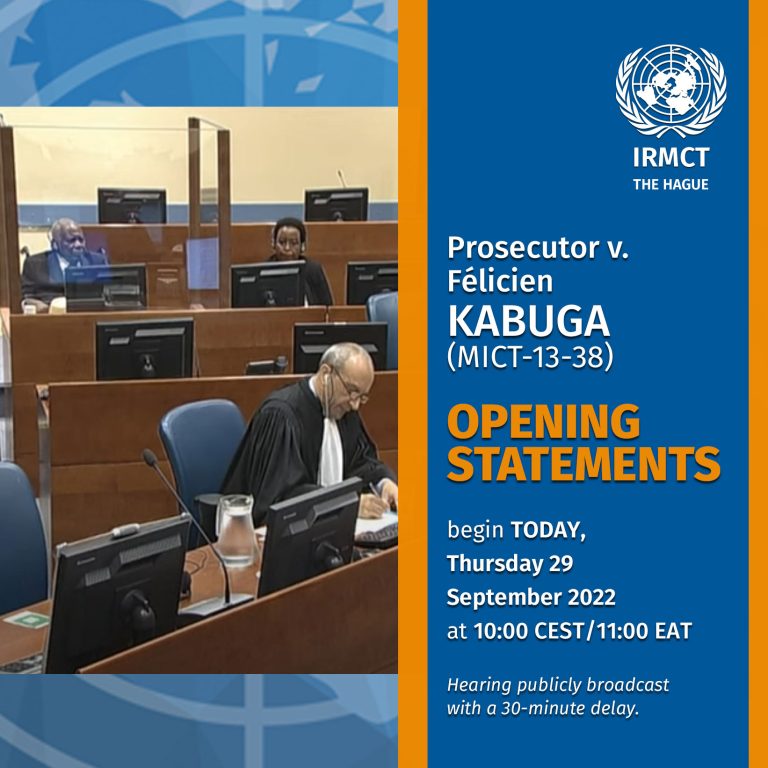
Today, the Office of the Prosecutor (OTP) of the International Residual Mechanism for Criminal Tribunals (IRMCT) presented its opening statement in the trial of Félicien Kabuga. Kabuga is on trial for the crimes of genocide, direct and public incitement to commit genocide, conspiracy to commit genocide and the crimes against humanity of extermination, murder and persecution, all committed during the 1994 Genocide against the Tutsi in Rwanda.
Reflecting on the commencement of this trial, IRMCT Prosecutor Serge Brammertz provided the following public statement:
Today, the victims of Kabuga’s crimes, and all Rwandan people, should be in the forefront of our thoughts. They have waited twenty-eight years for justice. My Office is committed to holding Kabuga accountable on their behalf.
Kabuga was among the world’s most wanted fugitives for two decades. My Office’s work to finally locate and arrest him in May 2020 was just the first step. Over the next few months, we will lay out the evidence of his crimes and his guilt, before the Trial Chamber and the public.
This trial will also be an opportunity to remind the world again of the grave dangers of genocide ideology and hate speech. Kabuga had a central role in provoking hatred of Tutsis, dehumanizing innocent civilians and paving the way for genocide. If we are to prevent further genocides, all of us must be vigilant against such incitement. Ethnic, national, racial and religious hate speech is not hard to identify – what is needed is the will to stop it in its tracks.
In its opening statement to the Trial Chamber, the Prosecution set out the main elements of the case against Kabuga. Having recalled that there can be no dispute that during 1994 there was a campaign of mass killing intended to destroy Rwanda’s Tutsi population, the Prosecution argued that Kabuga intentionally made two primary contributions to these crimes: first, by creating and operating Radio Télévision Libre des Mille Collines (RTLM), and second, by financing, arming and supporting the feared Interahamwe militia.
As the Prosecution noted, these were two sides of the same coin: “RTLM was the propaganda machine rousing hatred and ultimately violence against Tutsi; and the Interahamwe, receptive to RTLM’s rhetoric and trained, armed and primed to execute it on the ground.”
Before the genocide, Kabuga was one of the wealthiest and most influential individuals in Rwanda, a close ally of then-President Juvénal Habyarimana, his wife Agathe Kanziga and the Akazu clique that dominated Rwanda. Despite his very modest background and lack of formal education, Kabuga built a business empire, which he then leveraged to build relationships with political, military and business leaders across Rwanda.
With the advent of multi-party elections and the outbreak of armed conflict with the Rwandan Patriotic Front in the early 1990s, divides developed among the Rwandan leadership, between those committed to maintaining Hutu supremacy and those supporting ethnic peace and pluralism. Kabuga used his wealth and influence to support the “Hutu Power” movement and anti-Tutsi hate speech.
Working with other Hutu extremists, Kabuga organized the establishment of RTLM to spread genocidal ideology. He provided funds for the needed equipment, obtained broadcast frequencies, organized debt financing, registered RTLM and exercised management over it through the Comité d’Initiative, the sole executive body. RTLM – and its anti-Tutsi message – rapidly developed a wide audience following its first broadcast in July 1993. When the Ministry of Information tried to close RTLM for airing hate speech, Kabuga successfully defended the radio station and ensured its continued operations.
After the genocide began on 7 April 1994, RTLM was ubiquitous, broadcasting 24 hours a day and overtaking the public Radio Rwanda as the primary radio station. RTLM broadcasts called on Rwandans to “exterminate the Tutsi from the surface of the earth” and “make them disappear for good”. RTLM further directed the Interahamwe to attack specific people, and specifically called for Tutsi women to be raped and then killed.
In addition to his intimate involvement with the propagation of genocide ideology, Kabuga simultaneously gave direct support to the Interahamwe militia, who would become one of the key perpetrators of the genocide. He provided them with funding, procured and distributed weapons, organized training and later personally encouraged the killings. Kabuga initially supported Interahamwe groups in the Muhima and Kimironko areas of Kigali, before leaving Kigali for Gisenyi in mid-April 1994. In Gisenyi, Kabuga was then at the forefront of efforts to ensure the sustained supply of weapons, money, transportation and encouragement to the Interahamwe so that the genocide would continue. Kabuga finally fled Gisenyi and Rwanda following the end of the genocide in July 1994.
As the Prosecution argued in conclusion, the evidence will show “that Félicien Kabuga, acting in the cause of extremist beliefs, played a key part in bringing about the crimes and the almost unimaginable suffering that was unleashed across Rwanda in 1994.” (End)
